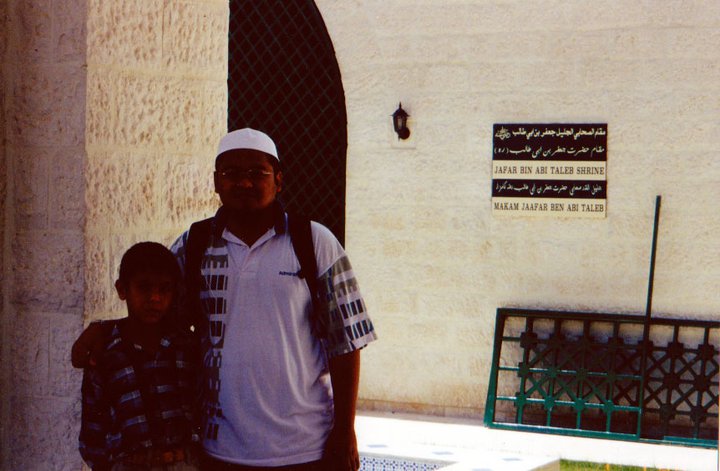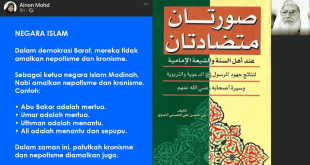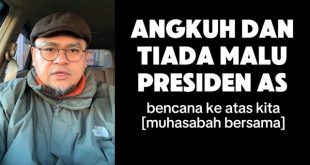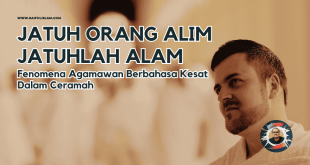
Bangunan lama sudah tiada
Ia satu bentuk ICONOCLASM.
Iconoclasm is the deliberate destruction of religious icons and other symbols or monuments, usually with religious or political motives. It is a frequent component of major political or religious changes. The term encompasses the more specific destruction of images of a ruler after his death or overthrow (damnatio memoriae), for example, following Akhenaten’s death in Ancient Egypt. – wikipedia
ICONOCLASM bukanlah ciri yang patut dikhususkan dan ditujukan hanya kepada ‘Wahhabiah’.
Ia wujud dalam semua bentuk gerakan Islah dan Tajdid, hatta reformasi dalam agama lain. Orang Kristian pun ada Calvinist Iconoclasm.
Kerana mahu mendalami Islah dan Tajdid sebagai cabang Sejarah Islam, saya perlu menambah pengetahuan dan kefahaman berkenaan hal ini. Teringat juga desakan Gerakan Kadizadeli yang mahu agar Balai Cerap Taqi al-Din dimusnahkan dan ia telah dimusnahkan pada 1580.
‘PEMBANGUNAN’ DI MEDAN MU’TAH, JORDAN
Semasa belajar dulu, saya mendiami kawasan al-Mazar al-Janubi di wilayah al-Karak, selatan Jordan. Perkampungan ini merupakan bekas tempat berkubunya tentera Rasulullah sallallaahu alayhi wa sallam semasa perang Mu’tah. Ada tiga makam sahabat di keliling rumah kami, di dalam bangunan serba sederhana, sejuk, dikelilingi pokok zaitun yang rendang. Kebanyakannya dibina di zaman pentadbiran Uthmaniah.
Jaafar bin Abi Thalib.
Zaid ibn Harithah.
Abdullah bin Rawahah.
Radhiyallahu ‘anhum.

Pada tahun 1995, semasa saya menziarahi makam Abu Ubaidah al-Jarrah radhiyallahu ‘anhu, ia hanya bangunan kecil dan tiada nilai ‘komersil’ atau pelancongan. Sesekali menyinggah, penghayatan terhadap Sirahnya lebih berkesan. Pada tahun 2000, segalanya berganti kompleks canggih dan mewah. Sejarah semakin terpencil hanya di dalam buku
Sesekali menziarahi makam mereka untuk mengukuhkan penghayatan Sirah Nabi sallallaahu alayhi wa sallam, ia sungguh mendamaikan. Setakat beberapa tahun saya di sana, tiada pulalah sebarang bid’ah dilakukan di makam-makam itu, kecuali maqam Jaafar al-Tayyar radhiyallahu anhu yang setiap 10 Muharram akan dikunjungi oleh syiah berbas-bas dan buat ritual meratap meraung, menangis.
Makam-makam itu kemudiannya dimusnahkan pada pertengahan 1990’an.
Selepas semuanya dimusnahkan, makam-makam itu menjadi sebahagian Kompleks Besar yang mewah, warna emas berkilau pada jeriji-jeriji besi dan malangnya bid’ah puak Syiah setiap 10 Muharram itu sama sahaja, tidak tertegah pun.
Memusnahkan segala kesan sejarah di Mekah dan kini di Madinah pula (Masjid Abu Bakr, Umar, Kubah hijau di makam Nabi sallallaahu alayhi wa sallam dll), saya yang jahil ni belum pasti berkenaan hujah berdalil-dalil naqli. Tetapi iconoclasm Arab Saudi terhadap kesan sejarah, menggantikan semuanya dengan bangunan super hebat metropolitan, saya sangat sedih dan terasa aib kepada anak-anak saya serta generasi Muslim akan datang.
LAPORAN TERKINI DI THE INDEPENDENT UK:
Three of the world’s oldest mosques are about to be destroyed as Saudi Arabia embarks on a multi-billion-pound expansion of Islam’s second holiest site. Work on the Masjid an-Nabawi in Medina, where the Prophet Mohamed is buried, will start once the annual Hajj pilgrimage ends next month. When complete, the development will turn the mosque into the world’s largest building, with the capacity for 1.6 million worshippers.
But concerns have been raised that the development will see key historic sites bulldozed. Anger is already growing at the kingdom’s apparent disdain for preserving the historical and archaeological heritage of the country’s holiest city, Mecca. Most of the expansion of Masjid an-Nabawi will take place to the west of the existing mosque, which holds the tombs of Islam’s founder and two of his closest companions, Abu Bakr and Umar.
Just outside the western walls of the current compound are mosques dedicated to Abu Bakr and Umar, as well as the Masjid Ghamama, built to mark the spot where the Prophet is thought to have given his first prayers for the Eid festival. The Saudis have announced no plans to preserve or move the three mosques, which have existed since the seventh century and are covered by Ottoman-era structures, or to commission archaeological digs before they are pulled down, something that has caused considerable concern among the few academics who are willing to speak out in the deeply authoritarian kingdom.
“No one denies that Medina is in need of expansion, but it’s the way the authorities are going about it which is so worrying,” says Dr Irfan al-Alawi of the Islamic Heritage Research Foundation. “There are ways they could expand which would either avoid or preserve the ancient Islamic sites but instead they want to knock it all down.” Dr Alawi has spent much of the past 10 years trying to highlight the destruction of early Islamic sites.
With cheap air travel and booming middle classes in populous Muslim countries within the developing world, both Mecca and Medina are struggling to cope with the 12 million pilgrims who visit each year – a number expected to grow to 17 million by 2025. The Saudi monarchy views itself as the sole authority to decide what should happen to the cradle of Islam. Although it has earmarked billions for an enormous expansion of both Mecca and Medina, it also sees the holy cities as lucrative for a country almost entirely reliant on its finite oil wealth.
Heritage campaigners and many locals have looked on aghast as the historic sections of Mecca and Medina have been bulldozed to make way for gleaming shopping malls, luxury hotels and enormous skyscrapers. The Washington-based Gulf Institute estimates that 95 per cent of the 1,000-year-old buildings in the two cities have been destroyed in the past 20 years.
In Mecca, the Masjid al-Haram, the holiest site in Islam and a place where all Muslims are supposed to be equal, is now overshadowed by the Jabal Omar complex, a development of skyscraper apartments, hotels and an enormous clock tower. To build it, the Saudi authorities destroyed the Ottoman era Ajyad Fortress and the hill it stood on. Other historic sites lost include the Prophet’s birthplace – now a library – and the house of his first wife, Khadijah, which was replaced with a public toilet block.
Neither the Saudi Embassy in London nor the Ministry for Foreign Affairs responded to requests for comment when The Independent contacted them this week. But the government has previously defended its expansion plans for the two holy cities as necessary. It insists it has also built large numbers of budget hotels for poorer pilgrims, though critics point out these are routinely placed many miles away from the holy sites.
Until recently, redevelopment in Medina has pressed ahead at a slightly less frenetic pace than in Mecca, although a number of early Islamic sites have still been lost. Of the seven ancient mosques built to commemorate the Battle of the Trench – a key moment in the development of Islam – only two remain. Ten years ago, a mosque which belonged to the Prophet’s grandson was dynamited. Pictures of the demolition that were secretly taken and smuggled out of the kingdom showed the religious police celebrating as the building collapsed.
The disregard for Islam’s early history is partly explained by the regime’s adoption of Wahabism, an austere and uncompromising interpretation of Islam that is vehemently opposed to anything which might encourage Muslims towards idol worship.
In most of the Muslim world, shrines have been built. Visits to graves are also commonplace. But Wahabism views such practices with disdain. The religious police go to enormous lengths to discourage people from praying at or visiting places closely connected to the time of the Prophet while powerful clerics work behind the scenes to promote the destruction of historic sites.
Dr Alawi fears that the redevelopment of the Masjid an-Nabawi is part of a wider drive to shift focus away from the place where Mohamed is buried. The spot that marks the Prophet’s tomb is covered by a famous green dome and forms the centrepiece of the current mosque. But under the new plans, it will become the east wing of a building eight times its current size with a new pulpit. There are also plans to demolish the prayer niche at the centre of mosque. The area forms part of the Riyadh al-Jannah (Garden of Paradise), a section of the mosque that the Prophet decreed especially holy..
“Their excuse is they want to make more room and create 20 spaces in a mosque that will eventually hold 1.6 million,” says Dr Alawi. “It makes no sense. What they really want is to move the focus away from where the Prophet is buried.”
A pamphlet published in 2007 by the Ministry of Islamic Affairs – and endorsed by the Grand Mufti of Saudi Arabia, Abdulaziz al Sheikh – called for the dome to be demolished and the graves of Mohamed, Abu Bakr and Umar to be flattened. Sheikh Ibn al-Uthaymeen, one of the 20th century’s most prolific Wahabi scholars, made similar demands.
“Muslim silence over the destruction of Mecca and Medina is both disastrous and hypocritical,” says Dr Alawi. “The recent movie about the Prophet Mohamed caused worldwide protests… and yet the destruction of the Prophet’s birthplace, where he prayed and founded Islam has been allowed to continue without any criticism.”
Mecca and Medina in numbers
12m The number of people who visit Mecca and Medina every year
3.4m The number of Muslims expected to perform Hajj (pilgrimage) this year
60,000 The current capacity of the Masjid an-Nabawi mosque
1.6m The projected capacity of the mosque after expansion
Saya memetik video dan akhbar Independent di atas, bukan bermaksud saya menyetujui keseluruhan isi kandungannya.
Saya mempunyai pendirian sendiri dalam penggunaan istilah Wahhabiyyah, dan saya tidak terlepas pandang pada memberikan penghormatan dan penghargaan kepada usaha gigih pemerintah Arab Saudi memperbaiki infrastruktur serta kemudahan jemaah Haji di Haramain. Tumpuan saya di dalam artikel ini hanya berkenaan perobohan secara besar-besaran seluruh kesan tinggalan sejarah di Mekah dan Madinah…
Haramain kali terakhir saya menziarahinya, hanya tinggal kenangan dalam ingatan…
HASRIZAL
43000 BSP
 Saifulislam.Com Pendidikan Jalan Islah
Saifulislam.Com Pendidikan Jalan Islah




erk..kalau zaman saya nanti pergi haji macam mana la agaknya ustaz.. moden sungguh. hilang feel~
Sayangnya. Tak sempat saya nak tengok bila saya ke sana 3 tahun lagi, Insya-Allah…
Sebagai penggemar sejarah, berita ini sungguh mengecewakan saya. 🙁
Assalamualaikum…sungguh menyedihkan…air mata tidak dapat dibendung lagi …tapi hakikatnya Allah yang Maha Penjaga akan menjaga kedua-dua tanah haramnya…
Wallahu’alam…
Inilah fitnah yg kelak akan memakan diri para pendokong manhaj ‘salaf’, lebih2 lg yg mengangkat syeikh muhammad abd wahab sebagai mujadid. berdegar2 membantah dan menutup segala jenis bidaah, sehingga demi mengelakkan khurafat yg mgkn berlaku, memusnahkannya sama sekali. Tetapi dalam masa yg sama, mendirikan pelbagai bangunan yg hebat2 dengan belanja berbilion USD. Kalau boleh mengeluarkan belanja yg begitu besar utk ‘kemudahan’ jemaah, kenapa tidak digunakan duit tersebut utk menghalang org dr melakukan ‘bidaah sesat’? drpd hancurkan tempat tersbut, kawal la supaya kawasan terbabit tidak menjadi tempat khurafat mengarut org lain, terutamanya puak2 Syiah. Tempatkan pegawai/askar/para asatizah yg menuntut utk memberi penerangan dan signifikan tempat tersebut kepada jemaah, ini bg saya, lebih bermakna dan bermanfaat, hatta ‘kesalahfahaman’ dan ‘kekeliruan’ aliran salafi wahabiyah boleh dijernihkan dgn pendekatan sebegini. Tp bila dah hancurkan segala monumen2 sejarah (mgkn mengunakan kaeadah usul sad zara’i brgkali), kemudian berlumba2 buat bangunan tinggi (persepsi org luar yg dtg), maka fitnah itu menimpa kepada Syeikh Muhammad Abd Wahab hatta kepada Syeikhul Islam Ibnu Taimiyaah dan Imam Ibnu Qayyim terkena ‘tempias’ makian org, WallhahuA’lam. (p.s: sekadar pendapat peribadi saya, harap tidak ada yg berkecil hati)
Inilah concern yang mendukacitakan kita. Lain hasrat guru, lain pembawaan murid
Assalamualaikum;
Akhirnya saya sampai juga ke Mu’tah, tempat ustaz pernah belajar; suasananya kering, tandus dan jarang disirami hujan. Ia berada di atas banjaran terutama bila melalui KINGs HIGHWAY, dan dapat dirasakan kesukaran tentera Islam mendekati Muktah dari selatan yang bergunung dan berpadang pasir.
Makam ketiga-tiga sahabat yang syahid (tetapi saya tidak dapat mencari makam utusan yang dibunuh dikatakan selepas Taffila) diziarahi dan mendatangkan perasaan bahawa sejarah dan sirah Nabi kita adalah “real” bukan dongengan, ia mendatangkan perasaan teguh, kukuh, takut, kagum dan seolah ia menjadi realiti yang dapat dibayangkan sewaktu perang yang didahului dengan syahidnya Zaid ibnu Harithah, Jaafar yang sangat menyerupai Rasulullah dan Abdullah; seterusnya kisah strategi Khalid Al Walid..
Terus terang saya katakan; penceritaan sejarah ini boleh menyegarkan kembali kelesuan; terutama kelesuan iman, perjuangan, dakwah dan ia boleh menjadi pengajaran hebat kepada anak muda.. Terima kasih Ustaz atas tulisan dan buku ustaz yang menyebabkan lonjakan hati menziarahi Al Urdun yang dipenuhi kesan dan laluan para nabi..
Saya melihat video setelah komen diatas ditulis;
Paling tepat, kesan sejarah adalah “evident”;
Setelah berada di Dubai dan lain-lain bandar di Timur Tengah; dan melihat telatah saudara Arab kita, dan bagaimana Bakkah juga akan dan telah ditukar menjadi tempat lepak dan bermewah – Starbucks, Coffee Bean, Hilton dll; dengan “bangunan super hebat metropolitan” sebagaimana tulis Ustaz..
Maka EMOSI (bukan akal!) saya hampir2 cenderung menerima teori bahawa penyelamat dan pemimpin akan datang dari timur; dahulu ada antara kita menyalahkan TE Lawrence; atas kejatuhan Khalifah Uthmaniyah, sehingga akhirnya kita sedar ia kesan kemunduran akhlak dan sistem politik dan pemerintahan;
Anak cucu kita nanti akan menyalahkan siapa?